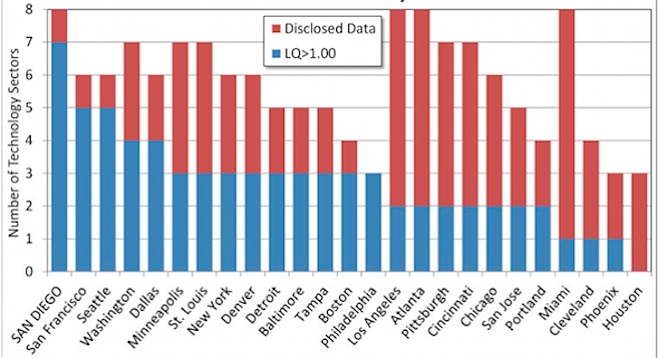 Facebook
Facebook
 X
X
 Instagram
Instagram
 TikTok
TikTok
 Youtube
Youtube

Technology accounted for 11.1 percent of San Diego County jobs last year but 22 percent of total wages, according to a new study by Kelly Cunningham, economist for the National University System Institute for Policy Research. The reason for this stark difference: the average tech salary was $114,300 last year, compared with $49,700 for the average non-tech job.
The number of tech businesses rose by 7.3 percent last from from 2013, while the number of overall establishments only increased by 1.3 percent. However, the number of tech jobs rose by 2.7 percent, not much better than the 2.6 percent rise in overall employment.
The tech jobs include computers and electronics, telecom, biotech/pharmaceuticals, medical equipment, computer systems design, environmental services, biological research, recreational goods production (mainly golf equipment), and transportation equipment. Computers and electronics production peaked in 2000 and has declined by half, says Cunningham. Golf equipment peaked in 1998 and has been in a slow decline. Environmental tech has been about flat.
The big winner is scientific research and development services — primarily, biotech and pharmaceutical industries; second is wireless communications.
San Diego has a significant presence in seven of eight major tech areas, notes Cunningham; none of the other 24 major metro areas can make that statement


Technology accounted for 11.1 percent of San Diego County jobs last year but 22 percent of total wages, according to a new study by Kelly Cunningham, economist for the National University System Institute for Policy Research. The reason for this stark difference: the average tech salary was $114,300 last year, compared with $49,700 for the average non-tech job.
The number of tech businesses rose by 7.3 percent last from from 2013, while the number of overall establishments only increased by 1.3 percent. However, the number of tech jobs rose by 2.7 percent, not much better than the 2.6 percent rise in overall employment.
The tech jobs include computers and electronics, telecom, biotech/pharmaceuticals, medical equipment, computer systems design, environmental services, biological research, recreational goods production (mainly golf equipment), and transportation equipment. Computers and electronics production peaked in 2000 and has declined by half, says Cunningham. Golf equipment peaked in 1998 and has been in a slow decline. Environmental tech has been about flat.
The big winner is scientific research and development services — primarily, biotech and pharmaceutical industries; second is wireless communications.
San Diego has a significant presence in seven of eight major tech areas, notes Cunningham; none of the other 24 major metro areas can make that statement
Comments